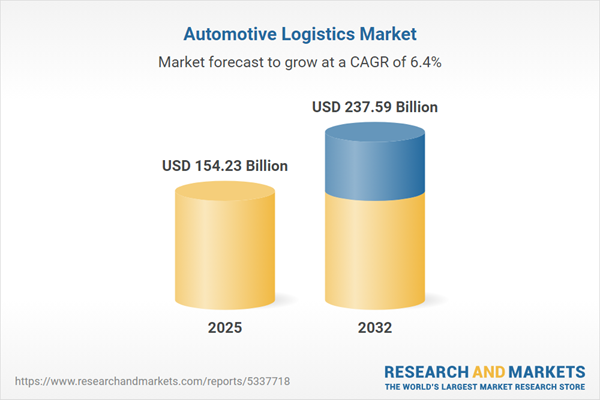Speak directly to the analyst to clarify any post sales queries you may have.
Automotive logistics is undergoing significant transformation as senior decision-makers respond to increasingly complex supply chains shaped by evolving regulation, new technologies, and demands for enhanced sustainability across all operational tiers.
Market Snapshot: Automotive Logistics Market Growth
The global automotive logistics market achieved a valuation of USD 144.98 billion in 2024, with projected growth reaching USD 154.23 billion in 2025 and USD 237.59 billion by 2032, reflecting a 6.36% compound annual growth rate (CAGR).
Expansion is driven by the rapid adoption of advanced technologies, improved cross-border logistics processes, and dedicated investments in digital platforms. Leading organizations are forming strategic alliances to address evolving compliance standards and environmental goals, enhancing risk mitigation and strengthening the value delivered across global automotive logistics networks.Scope & Segmentation of the Automotive Logistics Market
- Mode of Transport: Air freight provides rapid delivery for high-value automotive components, while rail transport is leveraged for cost-efficient bulk movements over extended distances. Road logistics supports last-mile distribution and specialized vehicle management. Sea freight facilitates international market connectivity and efficient handling of large-scale vehicle and component shipments.
- Service Type: Inbound logistics ensures steady flows of components to assembly plants, while outbound logistics handles distribution of vehicles and parts to end users. Reverse logistics manages returns and repairs, strengthening sustainability and cost control throughout the product lifecycle.
- Vehicle Type: Commercial vehicle logistics cater to fleet and industrial clients by prioritizing reliability, whereas passenger vehicle logistics focus on agile supply to dealerships and individual consumers to match shifting demand patterns.
- End User: Aftermarket logistics simplifies spare parts delivery and supports omnichannel distribution, while OEM logistics optimize manufacturing supply chains, synchronize vehicle launches, and align with dealer inventory requirements.
- Geographic Coverage: Key operators serve the Americas, Europe, the Middle East, Africa, and Asia-Pacific. Rapid digital adoption in China, India, Southeast Asia, Japan, and Australia fosters innovative logistics models and raises delivery standards across these markets.
- Key Companies: Leading firms—including Deutsche Post AG, Kuehne + Nagel International AG, Deutsche Bahn AG, DSV A/S, Ceva Group plc, Geodis SA, Nippon Express Co., Ltd., Yusen Logistics Co., Ltd., XPO Logistics, Inc., and Penske Logistics, LLC—drive market advancement by leveraging automation and setting benchmarks for operational efficiency.
Key Takeaways for Senior Supply Chain Leaders
- Logistics strategies are evolving in response to updated compliance requirements, with emphasis on resilient supply networks and proactive disruption management.
- Real-time analytics and tracking technology enable full visibility across logistics chains, enhancing operational responsiveness and supporting data-driven decisions.
- Energy-efficient fleets and sustainable logistics infrastructure are now central to meeting regulatory requirements and environmental expectations from stakeholders.
- Collaboration between automotive OEMs and technology providers improves operational agility, allowing adaptive responses to rapidly changing regulatory landscapes.
- Adoption of multimodal transport solutions supports supply continuity, enabling strategic flexibility and agile response to both customer and geographic requirements.
Impact of 2025 US Tariffs on Cross-Border Supply Chains
The introduction of new US tariffs is creating added regulatory complexity for automotive logistics providers. In response, companies are enhancing global oversight with nearshoring, leveraging free-trade zones, and using bonded warehouses to meet new requirements and maintain operational efficiency. Coordinated planning across air, road, rail, and sea modalities is supporting resilience and mitigating potential delays at borders, helping organizations sustain reliable operations amid variable trading conditions.
Methodology & Data Sources
This analysis draws from comprehensive secondary research utilizing established industry and public resources. Findings were reviewed and validated by panels comprising logistics and transport technology experts, ensuring actionable relevance for senior executives and strategy leaders.
Why This Report Matters
- Presents strategic frameworks to guide digital transformation initiatives and operational sustainability for complex automotive logistics.
- Delivers clear, actionable recommendations for compliance management and risk mitigation amid evolving regulatory demands.
- Supports the creation of scalable, future-ready logistics strategies that address changing customer expectations and global market shifts.
Conclusion
Senior supply chain leaders can utilize this report to sharpen logistics strategies, pursue sustainability targets, and maintain organizational agility in a rapidly evolving market landscape.
Additional Product Information:
- Purchase of this report includes 1 year online access with quarterly updates.
- This report can be updated on request. Please contact our Customer Experience team using the Ask a Question widget on our website.
Table of Contents
3. Executive Summary
4. Market Overview
7. Cumulative Impact of Artificial Intelligence 2025
Companies Mentioned
The companies profiled in this Automotive Logistics market report include:- Deutsche Post AG
- Kuehne + Nagel International AG
- Deutsche Bahn AG
- DSV A/S
- Ceva Group PLC
- Geodis SA
- Nippon Express Co., Ltd.
- Yusen Logistics Co., Ltd.
- XPO Logistics, Inc.
- Penske Logistics, LLC
Table Information
| Report Attribute | Details |
|---|---|
| No. of Pages | 198 |
| Published | November 2025 |
| Forecast Period | 2025 - 2032 |
| Estimated Market Value ( USD | $ 154.23 Billion |
| Forecasted Market Value ( USD | $ 237.59 Billion |
| Compound Annual Growth Rate | 6.3% |
| Regions Covered | Global |
| No. of Companies Mentioned | 11 |









